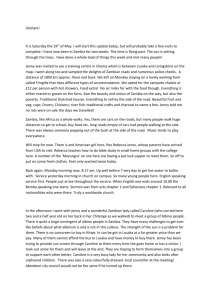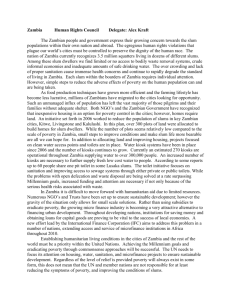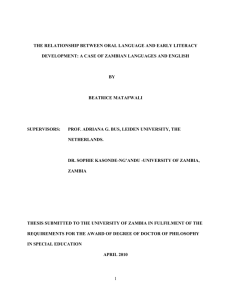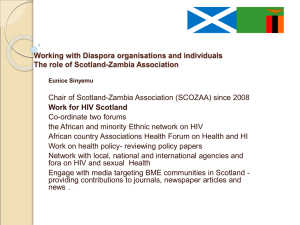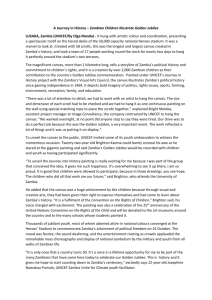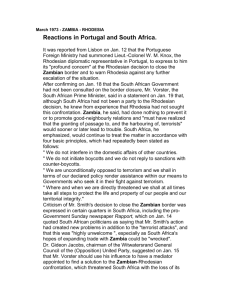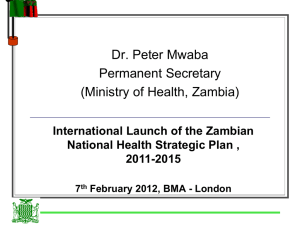RADIO TIMB SHARING AND THE NEGOTIATION OF LINGUISTIC
advertisement
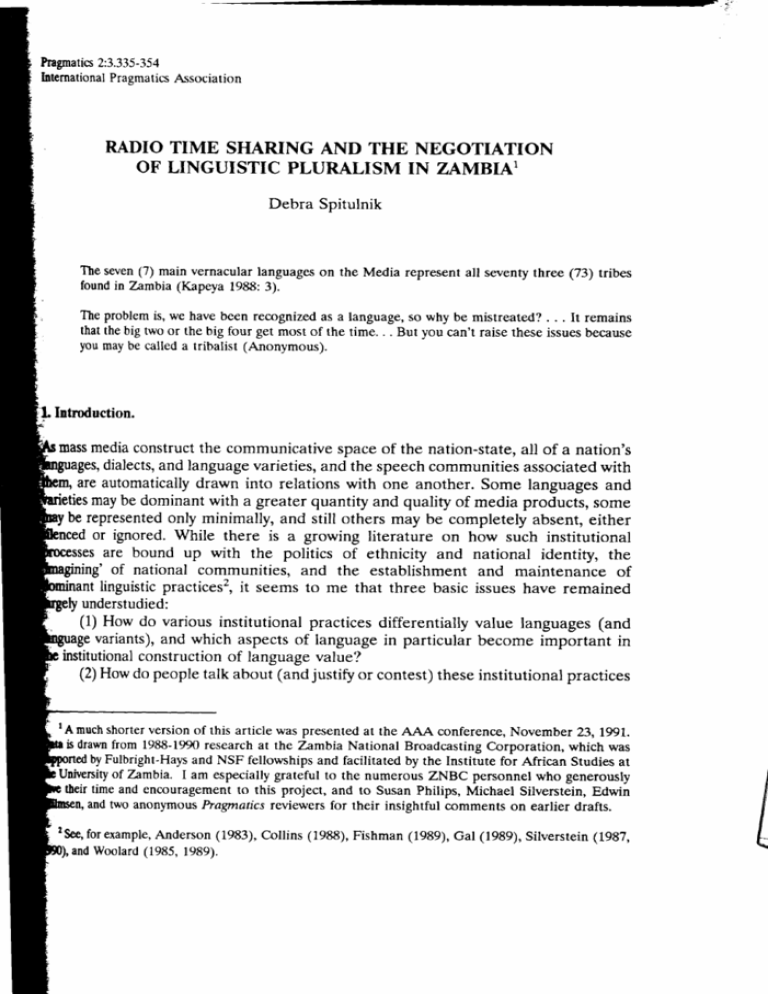
-354 Pragmatics 2:3.335 International Pragmatics Association RADIO TIMB SHARING AND THE NEGOTIATION OF LINGUISTIC PLURALISM IN ZAMBIA1 Debra Spitulnik Theseven(7) mainvernacularlanguages on the Media representall seventythree (73) tribes foundin Tambia(Kapeyal98S: 3). , Theproblemis, we havebeenrecognizedas a language,so why be mistreated?. . . It remains thatthebig twoor the big four get mostof the time. . . But you can't raisetheseissuesbecause youmaybe calleda rribalist(Anonymous). L Introduction. mass mediaconstructthe communicativespaceof the nation-state,all of a nation's dialects, and languagevarieties,and the speechcommunitiesassociatedwith are automaticallydrawn into relations with one another. Some languagesand maybe dominantwith a greaterquantityand quality of media products,some berepresented only minimally,and still others may be completelyabsent,either or ignored.While there is a growing literature on how such institutional are bound up with the politics of ethnicity and national identity, the ing' of national communities,and the establishmentand maintenance of linguisticpractices2,it seemsto me that three basic issueshave remained understudied: (1) How do various institutional practicesdifferentially value languages (and variants),and which aspectsof languagein particular become important in institutional constructionof languagevalue? (2)Howdo peopletalk about (andjustify or contest)theseinstitutionalpractices I A muchshorterversionof this articlewaspresented at the AAA conference,November23, 1991,. isdrawnfrom 1988-1990 researchat the TambiaNational BroadcastingCorporation,which was byFulbright-Hays and NSF fellowshipsand facilitatedby the Institutefor African Studiesar Univenityof Zambia. I am especiallygrateful to the numerousZNBC personnelwho generously I Oeirtimeandencouragement to this project,and to SusanPhilips,Michael Silverstein,Edwin andtwo anonymous hagmaticsreviewersfor their insightfulcommentson earlier drafts. 2See,forexample, Anderson(1983),Collins(1988),Fishman(1989),Gal (1989),Silverstein(Lg87, andWoolard(1985,1989). 336 DebraSpinlnik and valuations? (3) How are (1) and (2) related?How is discourseabout languagevaluesrelated to the valuations of languagein practice? This article attempts a preliminary exploration of these issuesthrough a case study of the politics of linguisticpluralismin Zambian radio. Echoing the introductory '73 quotes, we will examine how seven radio languagesare made to "represent" ethnic groups, and how certain languages are accorded high status while others are "mistreated." Before turning specifically to the Zambian situation, however, we will elaborate the issuesraised above and sketch out their connectionsto the problem of language ideology as it has been variously defined in recent work. In some analysesthese types of commentsand practices - e.g. evaluating some languages as "better" than others or constructing a national scheme of linguistic pluralism - would be considered language ideologies, or evidence of language ideologies.Certainly thesephenomenaare'ideological'in the sensethat they feed into and are fuelled by relations of power and interesr.They are also 'ideological' in the sense that they are tied up with the cultural conceptions(or modes of understanding and evaluation) that characterize any given society.And finally, they are 'ideological' in the sense that languagescan representspeech communities, and thus become the focus of political strugglesover who counts and is counted in the national arena. As both Woolard (this volume) and Friedrich (1989) point out, such applications of the term "language ideology" traverse the complex (and often competing) formulations of ideolog5r in social theory, e.g. as shared beliefs, secondary rationalizations,and modes of legitimating power relations.These types can overlap to some degree and may also be differently defined in terms of where ideology residesand how, analytically,it can be distilled. Thus some definitions revolve around distinctions between "explicit" and "implicit" ideology, or the relationship of consciousnessand speech to ideologieswhich are embodied "in practice." But as the applications of the term "ideology" proliferate, it seemsto be less and less useful analytically. And if, as Friedrich suggests,"everything" is potentially ideological in the sensethat the cultural construction of meaning and value is bound up with relations of power and interest (1989: 300), then the term is only useful in a technical sense within a theoretical framework which specifies what kinds of data count as ideology (i.e. what if not "everything"is ideological), and what kinds of relations of determination exist between these levels of phenomena (e.g. between the ideologicaland the non-ideological,or between power and culture). I raise these difficult theoreticalissuesnot so much to take a stanceon them, but to clear some ground, and to return to some more basic questionsabout the kinds of evidence that we use (1) to identify and distill cultural conceptions (and understandings)of language,languages,their speakers,and languageuse, and (2) to investigate the role of powerful institutions in constructing and maintaining these conceptions(or valuationsor 'ideologies').Rather than looking directly for ideas, or who wins, it seems more productive at least initially to examine such questions of language ideology through the recurrent themes that emerge from a range of types of historical changes, data (e.g. interviews,political documents,participant-observation, Lingtisticpluralismin Zambia 337 etc.).Silverstein (1987)and Woolard (1989),for example,locate languagevaluations in therhetoricalstructuring,folk views,and common metaphors, analogiesand tropes thatdominatecertain languagepolicy debatesin the United States.While any or all of thesediscursivemodesand moves might be called "languageideologies",neither of thetwo studiesuse this cover term, and instead frame the problem of the politics of valuespecificallyin terms of the production of certain kinds of discourseand language commentary. Followingthis approach here, I hope to introduce a further dimension to the problem,namely,how one might connect the ways that people talk about the values androlesof languages with broader institutional processes.Thus beyond identifying the commonthemesand tropes in the spoken battles over languagevalue in Zambia, I attemptto traceout their sourcesin and resonanceswith the national discourseon pluralism,the historical emergence of a scheme of language ranking, and the valuationof languagesin broadcastingpractice.And although this essayhas differential openedin a sensewith the spoken battles, I begin with the more general processesto establish the historicaland political momentum behind the various ways that people talk. 2.An overviewof radio's role in the negotiation of linguistic pluralism. Sinceits inception51 years ago, radio broadcastinghas been one of the most visible and contested arenas of language valuation and national language policy in Zambia. Fundamentally, what underlies the political volatility of implementation useon radio is that Zambian broadcastingis the primary state institution for language representing both national unity and national diversity.Radio is restricted to use only ei$t of the country's 15 or so languages:English, Bemba, Kaonde, Lozi, Lunda, Nyanja,and Tonga.At the sametime however,radio is chargedwith upholding Luvale, philosophy a national of ethnic egalitarianism(amongthe nation's"73 tribes") and the obvious aim of political encompassment,as encapsulatedin the national motto "One Zambia,One Nation." Collectively, then, the eight radio languagesare intended to both the nation as a whole and its internal diversity. rcpresent In this processZambian radio operates with trvo competing visions of the nation's diversity.Radio's use of different languagesis structured by both a vision of egalitarianism in line with nationalistdiscourse,and a hierarchicalranking of the ethnic which is linked to the political and demographicinequalitiesamong languages nation's theirspeech communities.As we will seein more detail below, Radio Zambia balances thesedifferentpluralismsin three basic ways: (1) through a differential allocation of radioairtimewhich both regulates language equality and gives languages different values,(2) throughvarious modes of establishingevaluationsof each of the unequal Zambianradio languagesvis-a-visthe country's national language English, and seven the interestsof 73 ethnic groups within the programming CI)by accommodating constraints of thesesevenlanguages. Whilethesevariousvaluationsof language"in practice"do not directly dictate 338 DebraSpiulnik the ways that Zambians talk about the politics of language value, there are strong relations of determination.The discussionbelow illustrateshow certain institutional processesgive a fixity and legitimacyto (i.e. naturalize) certain languagevaluations,but are also at times contested,manipulated,or simply ineffectivein producing consensus. A different kind of determination arisesfrom the particular structuresand functions specificto an institution in the sensethat they may focuson some featuresof language (e.g. phonology, syntax, code choice) as more critical than others in constructing languagevalue. As radio is a medium definedand structuredby time, wavelengths,and sound, it is not surprising that much of the concern over radio language use in multilingual situationssuch as Zambia has been about the allocation of airtime and channelsto different languagesand the normativeuse of "standard"or "non-standard" phonology.3 Additionally, there are somemodesof evaluatinglanguageswhich while implicit in broadcastingpractice, actually have their sources(or are just as solidly grounded) outside of radio, in national discourse,in labor markets, and in more general understandings about the relations between language,culture, and identity. For example, a major theme in the negotiation of linguistic pluralism in Zambia concerns the way in which "a language"is taken to emblematize a people, an ethnic group, or a political unit. Closely tied to this interpretation of languagesas representing collectivitiesare evaluationsof the communicativefunctions(or domainsor topics) that they canonicallyserye. Using Ferguson'sclassicformulation of diglossia,this would involve the "specialization of function" of different codes across different speech situations,contexts,and genres (1959: 328). But from the perspectiveof institutional practices,rather than speaker choice or overall contextualdistribution of codes,this of different languagesfor different "specialization"dependson how the appropriateness functions and topics is legitimated by some regularity of practices.For example in Zambian broadcasting, some languages are constructed as more "intellectually equipped"and others as better suited for "cultural expression"through their exclusive use for certain program types. Significantly,these perceived qualities of languagesare entangled with particular assessments of their speakers,e.g. as rural people, urban consumers,"illiterate","sophisticated","insignificant",etc., and I would argue that the two modes of evaluationare not really separable.These evaluationsdo not emanate strictly from radio, however, but are more directly grounded in the overall political economy of languagesin the country, os linguisticcompetence(and membership in certain speechcommunities)structuresaccessto education,labor markets,and political power. ' Interestin normativelanguage usealsofocuses vocabulary, on issuesof "non-standard" idiomsand syntax,as well as normsof languageinteraction(e.g.whetherbroadcasters exhibitproper turn-taking and deference). pluralismin Zambia 339 Linguistic 3. Pluralism in national politics. Ihe culturalization of ethnicity and the vicesof tribalism. Turning now to Zambia's national discourse on pluralism, there are 73 officially recognized ethnic groups which are constructedas equallydifferent,i.e. different in the sameway, in terms of their presumably harmless, apolitical 'cultural' differences. Amountingto a virtual culruralizationof ethniciyt,each ethnic group is said to have its ownunique traditions, dances,songs,and history, which it is encouraged to preserve and promote for the sake of the youth, tourism, and national identity. National discourse thus attempts to diffuse the political dimensionsof ethnicity at the same time thatit promotesan image of the state as tolerant of diversity.Referencesto the more volatiledifferencesbetween ethnic groups,particularly their inequalities in population, politicalpositions, and economicresources,are avoidedat all costs.Furthermore,there is no direct discussionof ethnic favoritism or conflict at the national level (except to denouncethem), although both significantlystructure social relations and politics, and arefrequenttopics of everydayconversation. Instead, politicians constantly invoke the national motto "One Zambi4 One Nation"as a symbol of a national unity which is predicated on being able to hold togetherand tolerate ethnic difference. On this note, Zambia is rather exceptional amongmodern African states as it has experiencedalmost no violent ethnic conflict, andhaspreventedany one ethnic group from monopolizing political power. But while claimingto have forged a national unity of."73 tribes united", the Zambian state has always simultaneouslyattended to the politics of ethnic difference and special interest. Zambia's first and long ruling presidentKenneth Kaunda carefully orchestrateda policy of "tribalbalancing"in political appointments,and early on articulated what became the generalconsensusin Zambia's political culture regarding the "deadly vice" of tribalism (Kaunda,L967: 11). Analogous to racism or sexism, tribalism is understood as discrimination or preference based on ethnic identity. Warnings against "falling victim t0 tdbalism" and denunciations of its divisive, retrogressive, and fundamentally un-Zambiannature pervade political oratory, and were continually raised during one-party rule (1972-1990)in illustrationsof what would ensueif a multi-party system wereadopted. In a very curious and complex way, then, Zambia's rhetoric of encompassing nationalism ("One Zambia, One Nation") and its philosophy of ethnic pluralism are mutuallyreinforcing,but are also in a constant state of tension with the possibility of ideological implosion. The national claim to build unity, fend off tribalism, and also encourage unique ethnic cultures,createsa cautiouspluralism within bounds, where diversity alwaysvergeson divisiveness,and where attention to difference itself borders on subversion. As we will soon see, this, in a nutshell, describesRadio Zambia's positionconcerninglanguagediversity as well. ;. * I 340 Debra Spitulnik 4. Democratic vs. hierarchical linguistic pluralism. A convergenceof language history, po@, and demographics. Alongside the national discourse of apolitical ethnic egalitarianism, Zambia has developed a national language policy which also stresses pluralism but ignores difference. This has been accomplishedmainly through sanctioningan extraordinarily high number of "official languages"- seven - which are all subordinated to the ethnically neutral "national language",English. The seven official Zambian languages are Bemba, Kaonde, Lazi, Lunda, Luvale, Nyanja, and Tonga, and they are the only Zambian languages used in broadcasting, schools, and government publications. English, the former colonial language,is the languageof government,higher education, and international communication.The choice of.whichseven,out of a total of between 15 and 20 distinct languagesand perhaps as many as 50 different dialectsa,was fairly well determined before independenceby the convergenceof severalprocesses:colonial language policy (especiallyin broadcastingand education), missionarywork, and labor migration patterns which establishedBemba and Nyanja as the colony's two urban lingua francas.s Crucially, English, Bemba, and Nyanja were the first languagesof Northern Rhodesian broadcasting,which started in 1947as a World War II information service. Following the war, Lnzi and Tonga were added as the serviceexpanded.According to Harry Franklin, the Northern Rhodesian Director of Information, nearly everyone understood these four "main 'root' languages of the country", and thus it was unnecessaryto add more languagesdespite several requeststo do so (1950: 16). Significantly, Franklin saw radio as having a key role in helping to standardize languagesand promote the dominance of some over others: andwe hope Africa'sbabelof tongues is oneof themaincauses of its people's backwardness, broadcast ratherthanto increase thern,andso to playa partin eventually to reducelanguages in the universal the eventual development of oneAfricantongue. . . andstill moreremotely, useof English(1950:16). Over time, the selection and dominance of the four languages became mutually reinforcing, and this arrangement was extremely convenient administratively, as their geographic distribution virtually aligned with the four compasspoints North (Bemba), South (Tonga), East (Nyanja), and West (I-nzi), which defined the major provinces of a The mostcomprehensive studiessuggestthar thereare 15to 20 distinct(non-mutuallyintelligible) languagesin Zambia, but many of the 73 ethnic groupsclaim to speak their own unique language vs."a dialect",which (Kashoki,1978).Behindthis is the complex,politicalissueof defining"a language" is further compoundedby the limited comparativedata on languagevariation in the country. Cf. Kashoki and Mann (1978)and lrhmann (1978). 5 Historical data is drawn mainly from Kashoki(1978),Roberts(1976),and Mytton (1978). Linpisticpluralismin Zambia 34I the colony.6In 1954,however, the two Northwestern Province languagesLunda and Luvalewere added to broadcasting (no single language was prominent in the province), and at Zambia's independencein 1964,an additional Northwestern Province language, Kaonde,was included. The contemporarylinguisticsituation inZambia is in large part a legacyof these trendsin colonialadministration,and the related trends in ethnic politics. In effect, the useof numerousZambian languagesin early radio broadcastingdid not help to reduce "theAfrican Babel", but helped to permanently establishsome of the basic terms in whichethnolinguisticdiversity is structured and experienced in Zambian society. Differentlanguagesbecame associatedwith different prestige values and domains of usein the nationalcon_text, primarily through the "uneven development" of the ethnic goupsspeakingthem/ and their concurrentunequal valuation in broadcasting.The highstatusandwidespreaduse of Bemba and Nyanja, "the big two", grew as their value in the urbanlabor marketsbecameestablished,and this was accompaniedby higher proportions of radio airtime for them. These two, along with Lozi and Tonga came to beknownas"the big four" as their first languagespeakersemerged as the major ethnic and regional power blocks in national politics (cf. Molteno 1974). For most of broadcasting histor!, Lozi and Tonga have had slightly lower proportions of airtime thanBembaand Nyanja,but more than the three Northwestern languageswhich are associated with much smaller populationsand ethnic power bases.The use of these threein contemporaryZambia is fairly limited to their own mother-tongue populations (e.g.l%o of all ZambiansspeakKaonde,while 37oof the countryis ethnicallyKaonde). By contrast,the Bemba and Nyanja languagesfar outreach their ethnic populations (l9%oand l6Vo) and are spoken by 56Vo and 42% of all Zambians, respectively (Kashoki, 1978).What obtainsthen in Zambia is not a situation of democrarrclinguistic pluralism in line with the nationaldiscourseof ethnic egalitarianism.All languages(or evenjust the seven chosen languages)are not equally valued, rather, they are hierarchicafu ranked(Figure 1). This languageranking is both a historical product of colonial administration and ethnic politics,and a partial diagram of the demographic andstatusinequalities among speechcommunities. ,l I ii I ii 6 The.ont.mporary discourseof regionalism,which flows directly from theserelationsof power established duringthe colonialperiod,is one of the major tropes of ethnic and languagepolitics in Zambia, anddeserves much more treatmentthan is possiblehere (cf. Mitchell 1956:28-30 and van Binsbergen 1985:203). 7 Thehistorical connections betweencolonial languagepolicyand the constructionof ethnicityin Zrnbiaremainro be fully investigated.But see Mitchell (1956)and van Binsbergen(1985) on how dbpritiesin missionization, rural development,and acressto educationand labor markets were imtrumental in the articulationof ethnic differenceand affiliation during the colonial period. 342 DebraSpirulnik Figure 1. Hierarchical linguistic pluralism rn Zambia. English colonial language international language urban lingua francas languages of dominant ethnic groups I Bemba, Nyanja I Bemba, Nyanja, Lnzi, Tonga \ "official languages' - Northwestern Province languages "nationallanguage' government,higher education, TV, radio, daily newspapers r r schools, radio, monthlynewspapers Kaonde, Lunda, LUVale I other languagesand dialects Luunda, Mambwe, Nkoya, Soli, Tumbuka, etc. 5. The politics of languagevalue in contemporary radio. Partitioning the linguktic universe. The politics of languagevalue, and especiallythe grounding of this scheme of hierarchical linguistic pluralism, occur most prominently in four domains in which the Zambian linguisticuniverseis essentiallypartitionedthroughbroadcastingpractice:the radio channel,airtime, administrativeresources,and program content.In the following, we will examine how the very way that the medium of radio is carved up establishes basic structural contrastswhich can become focal points for the construction (and contestation)of languagevalue. Since the early daysof broadcastingin Zambia the airwaveshave been carefully divided up among different languages,and concurrentlydistinct administrativeunits have been assignedresponsibilityfor the output in each of the different languages. Most pronouncedhasbeen the segregationof Englishvs. Zambian languages- in terms of both airwaves and program types - and one of the key issuesof attention and contestationhas been which Zambian languagesare treatedmore (or less)like English, which clearly occupies the privileged position in the language hierarchy. Table 1 illustratesthe specialstatusof English in terms of ZNBC's radio channels.8Not only are there currently more than twice as many hours for English as for all Zambian languages combined, but the two English channels also monopolize the more 8 While technically "channelndenotes a broadcastfrequency,it ZNBC's term for a distinct programmingschedule.ZNBC runsthe country'sonlybroadcasting operations: one televisionand four radio channels.Radio 3 is an externalservicefor SouthernAfrica. The three domesticradio channels are all centrallyrun from the capitalLusakaand havesimultaneous nationaltransmissionon their various frequencies. pluralisnrin Zambia 343 Linguistic prcstigious FM frequencies. Furthermore,up until 1991,Zambian televisionbroadcast exclusively in English,and presentlyit carries only one hour of Zambian languagesper day.The names"Radio 1" and "Radio 2" were introducedin 1989with the creation of "Radio4", and were precededby five other pairs of labels. The various alterations in boththe channels'namesand languagesreveal a constantattention to the politics of language value,and illustratethe ongoingpracticeswhich are necessaryto sustainand justiffcertainvaluations;we considerthem in detail below.e Trble1. ZNBC radio operations,1990. Radio I Radio2 Hours Frequencies languages7oof totalradiobroadcast time 04.50-24.05 SW,MW 3lVo 7 Zambianlgs 04.50-24.05 SW,MW, FM English 3l Vo Radio 4 Contin. 24 hrs FM stereo Enplish 38Vo From the late 1940s up to Zambian independence in 1964, broadcasting for Africansand Europeanswere separate.The "African Service"emanated operations fromLusaka(the Northern Rhodesiancapital) and the "English Seryice"came from (theSouthernRhodesiancapital).The African Servicecarried a few programs Salisbury in Englishfor Africans, but most English language programs were produced in the Southern Rhodesianstudios.Zambianbroadcastinginherited this operational imbalance andlanguage segregation at independence,and out of this situation the "Vernacular Scwice"(with 7 Zambian languages)and the "National Service" (with English only) werecreatedin 1964.Racialovertoneswere thus eliminatedwith both the rejection of thelabel"African"and the revaluing of English as something "National", i.e. rightfully belonging to the newlyindependentnation-stateand not any one race. But even with these newlabels,the comparativescopesof the two channelsand their implicationsfor valuationsremained fundamentally the same: Zambian languageswere still language segfegated from English,which stood apart as the languageof wider, national, and moremoderncommunication. Oppositionsto these distinctions erupted during the two years following independence as the channels' names were changed three more times, and controversies continuedas the allocationof languagesto each channelwas altered as well.ln1965,for example,the National Servicewas relabeled"the English Sewice",in anattemptto dispelany implicationthat the "vernacular"languagesof its counterpart werenotalso'national'. The implicationendured,however,and in 1966the Vernacular and EnglishServiceswere renamed "Home" and "General" thus even further accentuating differencesin scope. The Home Service, as something 'not-general', caniedconnotations of being specific, local, and even narrow. Resonating with 9 Sour..s, Handbookto the Federationof Rhodesiaand Nyasaland,1960(Salisbury:Government Printe4p.552.A Handbookto theRepublicof Zambia,c. 1965(Lusaka:GovernmentPrinter) p.105-7. (January29,1965- February10, 1967). l*hilo,nos.183-236 344 Debra Spitulnik Zambian idioms of ethnic origin and rootedness,the word "home" also signalled that the "vernacular" broadcastswere for rural and ethnic-basedaudiences,and tapped into their essentialidentities,e.g. the importance of a vernacular "[ZNBCrealizes] language asbeingthe [sic]mostandproper communicator anda trueidentifierof man'sbelonging. . . (Kapeya1988:2).' Even after the Home Service was relabelled "Radio 1" in 1989, ZNBC broadcasters continued to draw upon the themes of home and belonging in promoting the channel, e.g. in Bemba sloganssuch as "Kumwesuhualiwama",'At home (our place), it's nice'. The General Service,on the other hand,as something'not-home',did notbelong to anyone in particular. Associated with wider (more general) spheres of communication, and seeminglydissociatedfrom locality, ethnicity, and special interest, the General Serviceused the one languagewhich symbolizesthe transcendenceof such boundaries, English. This situation did not remain for long, however, and soon several controversieserupted over which languagescould rightfully share time with English on the General Service. In early 1966 "the big four" (Bemba, Nyanja, I-ozi, Tonga) were added with the rationale that their audienceswere larger and therefore they needed more hours. But a year later, I-ozi and Tonga were removed, leaving "the big two", which remained on the General Service with English for nearly 20 years, thus acknowledgingthe wider scopeof the linguafrancas and the possibilitythat they did not necessarilybelong to any one people. The problem, was however, that while Bemba and Nyanja are widely used by people of all ethnicities, their links to specific ethnic constituenciesremains a continually invocable reason for limiting their use at the national level. Bemba and Nyanja are simply not 'general' like English, and in selectingthem over others one is open to being "called a tribalist", as this complaint to the Ministry of Information and Broadcastingimplies: nSome languages have more hours than others [and] only nvo of the seven languages are on the General Service . . . [This is] unfair as far as the national motto of nOne Zambia, One Nation" is concerned. (Lrtter from Northwestern Province, received 13 August 1981, ZBS|101/1/5)." Since the national motto "One Zambia, One Nation" is about uniting an ethnically plural society,to these letter writers unity was violated by separatingout two Zambian languagesto share a channel with English. As the pressuresincreasedfor the General Service to "include everybody",the other five languageswere added in the mid 1980's but equal time was not granted. The situation was then dramatically reversed in 1988. All Zambian languageswere removed from the General Service, and it resumed its much earlier status as English only. Significantly,this 'all or nothing' decision evoked both praise and criticism, essentiallydrawing from two competing visions of pluralism. On the one hand there was the danger of having too much pluralism, i.e. a pluralism verging on divisiveness and confusion ("the African Babel"), with the possibility of contamination especiallywhen it came to mixing on a com-mon channel with English. One listener, for example,lauded the removal of Zambian languagesand expressedthe Lingubticpluralismin Zambia 345 "sincere hopethatthesechanges will helpbringbackto life the [sic]turnishedimageof the general service . . .^(Timesof Zambia,October16,1988,p.4). Othersfelt that the presenceof Zambian languageson a channel with English was too disruptive, or that only English was necessaryfor General Service programs such as health,farming,and educationalbroadcasts.The colonial bifurcation of English vs. all other languagesthus remained with lingering connotations of English as the sole language of prestigeand progress. On the other hand, there was the view of pluralism as positive and necessaryfor nationalcommunicationand the promotion of Zambian culture. Several listeners stronglyopposedthe removal of all Zambian languagesfrom the General Service, complaining for examplethat "English has the lion's share" while Zambian languages were "deprived of adequate air time" (Times of Zambia October 1988). One commented sarcastically,"I suppose that is the penalty they get for being Zambian languages" (Timesof Zambia October 11, 1988 p.2). The problemof singlingout two languagessurfacedagain in 1989when ZNBC introduced Radio 4, a 24 hour FM stereo channel designedto carry a mixture of pop musicprogrammingand commercial advertising.toInitially, some ZNBC staff thought Radio4 woulduseall eight languages,but from the outset it was English only. This was justifiedby claimsthat advertisersall preferred English, and that listeners who spoke only"the home languages"had no buying power and would therefore not be good audiences for a channelthat was to be supported by advertisingrevenue. Other staff notedthat since FM radio covered only urban areas, there was no need for the vernaculars which wete for villagers. But despite all of these seemingly objective appeals to externalfactors,none of these claims were supported by market research, andin fact they ran contrary to the well known fact at ZNBC that urban people do listento Bembaand Nyanja programs. Sowhy weren't the two linguafrancas added to the new urban-basedchannel? Overtwo-thirds of all Zambiansspeakat least one of theselanguages,and nearly half of all Zambianslive in urban areas.Certainly the listenerswere there. And regarding business interest,one senior executiveacknowledgedthat ib sjI6 F ;. "Bemba andNyanja thatbringanymoney[onRadio1]. That'swhy aretheonlytwolanguages theyareslotted at lunchtime,andtheyhavemmmercial programs . . . Thesponsors shunsome of these otherflanguages]." ZNBCexecutives knew that the two linguafrancas could have been successfulon Radio 4, but the choicewas political. In terms of ethnolinguisticimpartiality, the issue paralleled that of the embattled General Service languages:either have all Zambian languages on the new channel,or none at all. Even if Bemba and Nyanja reach wider 10Rrdio Zambia has had commercialadvertisingsince the 1960s,but Radio 4 was createdto increase advertising income.As ZNBC is a parastatalbody with corporatestatus,it can generateand controlledby the Ministry of Information.Radio 4 is thus invest itsownrevenues, but it is substantially lol a "commercial" (privatelyowned) radio channelin the Westernsense,and outside commercial interests havehadonly minimalimpactin shapingprogrammingdecisions. 346 DebraSpirulnik audiences,their connectionsto specificethnic groups lurks in the background of any decisionover their use. With the additionalaim of stylingRadio 4 after Western FM pop radio, the exclusiveuseof Englishnot only dispelledcontroversiesover "tribalism", but was a 'natural' consequenceof its statusas the modern, international language. The linguistic division of labor. The "penalty" that Zambian languages"get for being Zambian languages"thus extends beyond the allocationof airtime and channelsinto a virtual institutionalizationof what counts as their appropriate program content.Englishhas long been establishedas the languageof internationalnews,current affairsdiscussions, and the majority of scientific and formal education programs, while Zambian languagescarry mostly cultural and development programs.lr Ethnolinguisticpluralism is therefore contained not only within one channel,but also in terms of certaintopics,and specificallythrough an equal subordinationunder English in this linguisticdivisionof labor. Most prominent is the construction of language equality through linguistic uniformity. To take one example,the sameEnglishscript is used to prepare the daily Zambian language newscasts,so the news in each of the seven languagesis identical in format and content. The master text is extractedfrom the script of the preceding English language"Main News",but it is half the length, with the international items usually omitted. In this equal subordinationunder English, Zambian languagesare often equated with the rural folk, even though nearly half of all Zambians and over three-quartersof all radio listenerslive in urban areas.Thus similar to the Radio 4 case above, news staff claim to be just following the norms "out there" when they explain that the "sophistication"of the Radio 1 audiencediffers from the English language audience,and that a five minute excerptfrom the ten minute Englishnewsis adequate for them. As one senior news editor elaborated,"We wouldn't give an item on the SALT talks in Geneva. If they could understandthat, they could listen in English." Another said, "You don't pick something you maybe reachingilliterates. . . in Saigonor China,because There are complicated issues which wouldn't even make sense to them.' There was no audienceresearch,however,to substantiatetheseviews,and in a sense, the ability of newscastingto widen people's horizons was short-circuited by the assumptionthat their intelligencewas unalterablylimited. Many Zambians who know little or no English do have an interest in world events, and would like more international news in their own languages. In apparentcontrastto the newseditors'statements, ZNBC administratorspoint to the use of sevenlanguagesas examplesof broadcasting's dedicationto the national ll The functional segregationof languagesis even more severe in the education system. English is the medium of instruction after Grade 3, and Zambian languages are taught as subjects, with traditional culture as typical content. policyof "takingthings to the people." But what,, J;';'":::;:: :;:: people?Most informational programs in Zambian languagesare on national politics anddevelopment topicssuchas farming and health,and I would argue their audiences are in a sense"the imagined others" for the highly cosmopolitanEnglish speaking broadcasting elite. The audiencesthought of as "illiterates"are basciallythose who havenot reacheda certain level of formal education,in English, and to some media elitethisprecludesan ability to comprehendor share the sameworld views. Not onlydoesradio'sinstitutionalizationof limited programcontentfor Zambian languages perpetuatethis perceiveddivide, but the use of English master scripts for theseinformationalprogramsfurther regulateslinguisticuniformity (or egalitarianism), andconstructs English'shigh value as the scientificand factual language. By contrast, mostindependentlyscripted programs in Zambian languagesadhere to the politically acceptable expressionsof ethnic diversity - that is, traditional music, storytelling, and culturaltopics. Through these broadcastingpractices,then, the sevenvernaculars are valuedas equally transparent vehicles for communicating the same information to ethnically diversepeople, and as equally particularisticcodes for gaining accessto different ethniccultures.12 Tnu sharingon Radio I: Regulating language samenessand difrerence. fu indicatedabove,the allocation of radio airtime itself has emerged as one of the key measurements of linguisticequity:not all languageshavethe sameamounts(and types) of air-time,and thus the promotion of a simple linguisticegalitarianismas one would expectfrom the national philosophy is far from clear. Instead, Radio Zambia has developed a complexschedulewhich simultaneouslyregulates language equality and giveslanguages different, unequal values.With such a dynamic of languagevaluation, radioboth upholdsa vision of balanced pluralism and operates with its seeming contradiction, a schemeof hierarchicallinguisticpluralism. Significantly, the partitioning of radio airtime among seven Zambian languages andtheirabilityto represent73 ethnic groupsis limited to one radio channel. Figure 2 illustrateshow Radio 1's schedule carefully staggers the seven Zambian radio languages acrossthe different days and times of the week, and this establishesa basic imageof one national pie that is getting divided up. As people talk about this radio timesharing,variousdiscoursesof ethnolinguisticdemocracy are invoked which play intoandseizeupon thesestructuralcontrasts. 12 If Zt*birn languages are cultural reservoirsthen Englishis an economicreservoir,or at least theavenue for tappinginto economicresources.This issueneedsmore extensivetreatmentin terms of the overallpolitical economyof languagesand class dynamicsin the country, but briefly its significance in radio'snegotiationof linguisticpluralismlies in English'sexclusiveuse as the neutral language of translationand encompassment. The materialhere suggeststhat radio's (and the media elita')rolein constructing this seeminglynatural neutralityand transcendence of English cannot be undentated. 348 Debra Spirulnik Figure 2. Time allocation of Radio 1 languages (1990).13 Time Mon Tues Wed Thurs Fri Sat Sun 04.50-08.00 B T LnlLv Lz K N B 08.00-10.00 Lz K T Lv T Ln B 10.00-12.00 T Lv Lz T Ln Lz T 12.00-14.00 N B N B N B N 14.00-16.00 T LnlLv Lz Lz K N Lz 16.00-18.00 Lz K T Ln Lz B N 18:00-20.00 T Lz Ln K Lv Lv T 20.00-24.05 Lz N B N B T B [B Bemba; K Kaonde; Ln Lunda; Lv Luvale;Lzl.ozi; N Nyanja; T Tonga] Below, we see that the national motto "One Zambia, One Nation" becomes a dictum of democracy, i.e. equal representation for all, which then feeds into various modes of measuring language "equality" and "inequality." The middle term in this equation is the essentialistnotion that a languageis a "true identifier"of a people, thus: if languages represent people, then equal representation for everyone in radio will occur through equal distribution of radio's resources (airtime, programs, staff, etc.) across these different languages.One problem which emerges however, is that if languagesdo emblematize people, how are 73 different peoples represented by only seven languages?This section closeswith an illustration of how ZNBC handles such difficult cases. In one sense the schedule in Figure 2 presents a picture of distributional equality, where no particular language seems privileged over others. Each day a different languageopens the station, no languagedominatesany large time blocks, and acrossthe weekly cycle, every time slot is shared by two or more languages.A similar construction of distributional equality occurs in the Radio 1 news schedule,where a sequenceof back-to-backnewscastsin each of the sevenlanguagesis broadcastthree times daily, starting at 6.00, 12.20,and 17.20.Within each of these three news periods the newscastsare identicalin format and content,but the ordering of languagesdiffers at different times of the day, thus in effect no single languagealwaysgets first place at news time. 13 Based on Zambia National Broadcasting Corporation Radio One hogramme Quarter 1990. Schedule, First pluralismin Zambia 349 Linguistic At the sametime, however,there are great disparitiesin the quantity and qualig of airtime allocatedto each language,and this is summarizedin Table 2. Table2. Radio time sharingon Radio 1.14 Weekend hours l-ate nights PEAK TIMES daily TT WFSu TuThSa 15 daily 7 TuTh MWFSu 23 19 daily 8 Sa Lozi I7 18 daily 4 M Luvale 8 9 Tu-Sa 2 Kaonde 7 8 TuThF 0 Lunda 5 8 Tu-Sa 2 % Zambians speaking language Vo Radio 1 airtime Bemba 56% 19Vo Nyanja 42 Tonga Days broadcast Lunch slots 'The big four" have roughly the same amount of airtime, while the three Northwestern Provincelanguageshave much less,and do not occur every day, except in newscasts. In termsof measurablehours then there are two tiers - Bemba, Nyanja, Tonga, and Lozion one level,ranked above Luvale, Kaonde, and Lunda. The high valuation and demographic dominance of Bemba and Nyanja over the other five languages are reflectedmore in the allocation of peak times, and other forms of institutional favoritism. The rwo linguafrancas have the most late night slots, numerous weekend programs, andthe dailylunchtimeslots,all of which attracthigh advertisingvolumeand alsocorrespond with the typical urban laborer's off-work schedule. The most pervasivetheme in both listeners' and broadcasting personnel's discourseabout these language valuations is that radio languages represent homogeneous and relatively monolingual speech communities, i.e. ethnic groups. Radio's elaboratepartitioningof its universeof addresseesat the most general level, asseparate but equal speechcommunitiesbasedon language,draws from and feeds intothisessentialist view. Thus, while managementstatementssay that "the seven (7) mainvernacular languageson the Media representall seventythree (73) tribes found in Zambia"(Kapeya,1988:3), some people simply do not feel represented;they want theirpieceof the nationalpie. Many such complaints,as we have alreadyseen,allude to thenationalmotto "One Zambia, One Nation" in making demands for a linguistic 14 Colurnn1 is basedon Kashoki 1978:39. Other tabulationsare basedon Fisure 2. 350 DebraSpitulnik democracy.While this motto signifiesa vision of equal inclusion,the closelyrelated nationalistslogan"One Man, One Vote" hasbecomea major trope for measuringequal representation,as in this letter to Radio Zambia: 'lf we are all Zambians, then we should all get the same privileges. Kaonde should be on the radio for the same amount of time as the other languages.Equal hours for each tribe." (Mytton, 1978: 217,) Building on the view that one languageis "a true identifier" of one people, a whole series of one-to-one correspondencesor distributionaltropes have thus emerged as assessmentsof ethnolinguisticequity: one language,one people, one culture; equal hours for every language,etc. In this ongoingdebate over the three Northwesternlanguages,egalitarianismis also measuredin terms of another kind of one-to-onecorrespondence, that of regional distribution. Some broadcastersand listenerssay for example that the Northwestern Province is unduly favored with three radio languages,while the five remaining languagesare made to cover the eight other provinces.According to this view, some provincesare actually shortchangedby having no unique radio languageof their own, or by having their other languagesgo unrepresented.But Northwesternerssee it differently.To them the criterion of impartialityis not one languageper province,but equal hours per language,as this broadcasterexplainedin 1989: "Theproblemis,wehavebeenrecognized asa language, sowhybemistreated? . . . It remains thatthebigtwoor thebigfourgetmostof thetime.. . Butyoucan'traisetheseissues because youmaybe calleda tribalist." During 1989,ZNBC's concernover suchgrowing sentimentswas considerable. Originally Radio t had been divided into five different departments:Bemba Section, I-ozi Section, Nyanja Section, Tonga Section, and Northwestern Section. This bureaucraticdivisionin itself clearlymarked the statusof "the big four" as againstthe others,and ZNBC's responsewas to administrativelyrepartitionthis linguisticuniverse. The Northwestern Section was split into three distinct languageunits (the Kaonde Section,the Lunda Section,and the Luvale Section),and each was allocatedthe same number of employeesas the other four sections.An administrativeanalog of linguistic egalitarianismwas thus created:one language,one section.Radio time was not changed however. Other voicesof contestationcome from Zambianswhosefirst languagesare not any of the seven national languages(Mytton I974, 1978). While national statistics suggestthat suchpeople compriseroughly40Voof.the total population,multilingualism is extremely high and in actuality lessthan 5Voof all Zambians do not understand any of the sevennational languages(Kashoki, 1978:19-21,38-9).Still, periodic demandsfor recognition are common, as this letter from a Nkoya listener illustrates: "L-ozi isn't representative of Nkoya, so we should have our own broadcasts. . . . We won't accept a situati<ln of being considered as a sub-group of l,ozi!' (received 7/89, ZNBC) The executive handling this said he would check into the government policy to determine if Nkoya was "a languageor just a dialect,"and presumablythis would decide pluralismin Zambia 351 Linguistic whetherthe Nkoya people could be considered"a sub-group"of the neighboring Lozi people.In the difficult conflation of 73 into 7, ZNBC thus attempts to dispel the essentialist ideathat one languagerepresentsone ethnicgroup. In a similar vein, some Zambians invokethis 'language'vs.'dialect' argument in assertingthat there are no morethan 6 or 7 Zambian'languages'in the country, and that some radio languages canbe removedwithout sacrificingcomprehension.A corollary emergeshere from the earliertheme'a languageequalsa people': 'a dialect equalsa sub-group'.While the formerhavereal status,the latter are insignificant.OneZambian explainedfor example thatthe Northwesternlanguagesare more like dialectsof Bemba: "There arethese whatarethey,Lunda,Luvale, andKaonde.No onewill argue smalllanguages, Bemba,Nyanja,Tonga,and lozi thattheycan'tuseBembain the Northwestern Province. would be enough." But as the Nkoya letter above makes clear, for some the issue is not about comprehensibility but representation. According to the last national survey, radio language comprehensionwas extremely high acrossthe Zambian population, with the meannumberof radio languageslistenedto overall at 2.9 (Mytton 1974:26). Indeed, RadioZambiaaudiencesare not as fragmentedas the scheduleswould suggest,due to the high degreeof multilingualism in the country. Many people listen to Radio 1 throughoutthe whole day, and others tune in selectively to programs in several differentlanguages. To some degree then what listenersdo is orthogonal to all of this concernover radio time sharing. Comprehensionis not really the point, however, if languagesare viewed as emblems of autonomousethnic groups: to be excluded from radio is tantamount to beinga "sub-group",encompassedby one of the selected seven. To get around this problemof representation, ZNBC has pursued other avenuesfor allowing linguistic diversityto emergein its programming. For example, in the Nkoya case above, the ZNBCexecutivesaid he would insure that some Nkoya songswere played during the Lozitime slots.Thus consonantwith the linguistic division of labor discussedearlier, criesfor representationare met by the inclusion of cultural material. While the time blocksandnamedradio languagesthemselvescannot be tinkered with, small glimmers of linguistic diversitygreaterthan the chosensevencan occur on the airwaves,but they areof the safecultural kind. 6. Conclusions. ln conclusion, I would like to briefly consider how extensive and effective Radio Zambiais in negotiatingtwo kinds of linguistic pluralism, and then return to the initial questions of how to characterize"languageideology." Zambian radio has been faced withtheimmensely complextask of reconcilinga national philosophyof egalitarianism witha fairlyrigid linguistichierarchygroundedin the demographicsof its audiencesand the long history of differential language valuation in the country. Since the two pluralisms are fundamentallyopposed and never fully resolvable, as we have seen, 352 DebraSpiulnik apparent inconsistencies in broadcastingpracticecan be seizedupon as focal points for contestation,especiallyby thosewhoselanguagesare excludedor used only minimally. Even so, it is to Radio Zambia's credit that it has supported such a high number of languageswithin the economicand physicalconstraintsof one broadcastingoperation. The only drawback,it seems,is that in its responseto the dominant interpretationsof pluralism in national politics - where diversity is seen to verge on divisivenessand acts of recognizingdifference are potentially "tribalistic" - Zambian broadcasting'sextensive promotion of English has weakened its ability to adequately provide for all of its listeners in the seven Zambian languages.In this sense, pluralism is not really negotiated at all, it is muted. It is tempting to relate this handling of linguisticpluralism to the wider issues of national integration and the diffusion of ethnic conflict in the country, but these processesfar outreach the modes of languagevaluationdiscussedhere, and are more dependent on factors such as economic stability and political representation.More narrowly however, Radio Zambia's role and effectiveness in establishing and reproducing languagevaluesis extensiveand beginsduring the colonial period, as we have seen. In particular, radio's differential allocation of resources(e.g. channels, airtime, staff, and program types) among the eight radio languagesis very closelylinked to the construction of socialinequalitiesamong the speakersof these languages(as well as others who do not feel "represented"by radio languages),and this deservesmore detailed study. The approach here, however, has not been so much to assessthe role of a powerful institution in producing a net linguistic effect, but rather to trace out how radio's negotiation of linguisticpluralism is structured (and understood) in terms of various historical processes,political discourses,and cultural understandings of the relation between languagesand peoples. If these processesare mutually determining and complexly entangledover a 51 year history, on which side of the equation does one locate "languageideology"?One might call the languagevaluationsthat emerge through the dynamics of broadcasting "languageideologies which are embodied in practice", while the political discoursesand cultural understandings(as evidencedin verbal data) might be termed "explicit languageideologies."But basicallythis implicit/explicit dMde is just a shorthand for the different kinds of data used to distill "ideologies." As we have seen. both schedules and talk about schedules establish and construct interconnected languagevaluations.Invariably theseare tied up with relations of power and interest,in terms of both the national politicsof representationand broadcasters' perpetuation of their elite distinctions.It has been suggestedhere that to call all of these valuations, interests,discoursemodes, and cultural understandings"language ideologies" conflates several social, cultural, and linguistic processesunder one cover term, and hopefully this case study has sketched out some avenues for investigating their complexity. Linguisticpluralism in Zambia 353 I References I Anderson,Benedict (1983) Imagined communities: Reflections on the oigin and spread of nationalism. london: Verso. I Binsbergen, Wim van (1985)"From tribe to ethnicity in Western Tambia: The unit of study as an ideological problem."In W. van Binsbergenand P. Geschiere(eds.),Old modesof productionand capitalist encroachment. [,ondon: KPI, p.18I -233. Collins, James (1988)"Hegemonic practice:Literacyandstandardlanguagein publiceducation.'Working papers andproceedings of the Centerfor PrychosocialSmdies,no. 21. Chicago:Center for Psychosocial Srudies. I ' Ferguson, CharlesA. (1959)"Diglossia.n Word 15:325-40. Fishman, JoshuaA (1989)Langtage and ethnicityin minoity sociolinguisticperspective.Philadelphia: Multilingual Marrers. Franklin,Harry (1950)Repon on 'the saucepanspeciat': Thepoor ntan's radio for wal populations. Lusaka: Government Printer. I Friedrich, Paul( 1989)"L-anguage, 9l:. 295-312. ideology,andpoliticaleconomy." Ameican anthropologist Gal,Susan(1989)"l-anguage and political economy."Annual reviewof anthropologt18:345-67. Kapyr, Mwansa(1988) "The use of vernacularlanguagesin broadcasting."Paper presentedat a broadcasting seminarin Maputo, Mozambique. Kashoki, Mubanga E. (1978)"Thelanguagesituationin Zambia."In S. Ohannessian and M. E. Kashoki (eds.), p.9-46. Kashoki, Mubanga E. and MichaelMann (1978)"A generalsketchof the Bantu languages of Zambia." ln S.Ohannessian andM. E. Kashoki(eds.),p.47-100. Kaunda, KennethD. (1967)Humanismin Zanzbiaand a gtide to its implementdtion, part L Lusaka: Government Printer. l.ehmann, D. A (1978)"l.anguages of the Kafue basin:Introductorynotes.nIn S. Ohannessianand M. E.Kashoki (eds.), p.101-20. ' Mitchell, J.Clyde( 1956)Thekaleladance.Rhodes-Livingstone Papers,no,27. Manchester:Manchester UnivenityPress. Molteno, Robert(1974)"Cleavageand conflict in Zambianpolitics: A study in sectionalism."In W. Tordoff (ed.),Politicsin Zantbia.Berkeley:Universityof CaliforniaPress,p.62-106. I ' Mytton,Graham (1974) Listening looking and leaming: Report on a national mass media audience survey inZambia(197A-B). Lusaka: Institute for African Studies. Mytton,Graham (1978) "language and the media in Zambia." In S. Ohannessian and M. E. Kashoki (eds.),p.207-27. 354 Debra Spiutnik Ohannessian,Sirarpi and Mubanga E. Kashoki (eds.) (1978) Langtage in Zambia. [,ondon: InternationalAfrican Institute. Roberts,Andrew (1976)A hbtory of Zambia. New York: Africana. of the Silverstein,Michael (1987) 'Monoglot 'standard'in America."Workingpapersand proceedings Centerfor PsychosocialSrudies,no. 13. Chicago:Center for PsychosocialStudies. Silverstein,Michael (1990)'The skin of our teeth:Registers,poetics,and the First Amendment."Paper presentedat the American AnthropologicalAssociationannualmeeting,New Orleans. Woolard, Kathryn A. (1985) "l-anguagevariation and cultural hegemony:Toward an integration of sociolinguisticand socialtheory."Ameican ethnologist12:738-48. Woolard, Kathryn A. (1989) "Sentencesin the languageprison: The rhetorical structuring of an American languagepolicy debate."Ameican ethnologist16:28-78.
